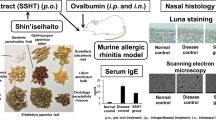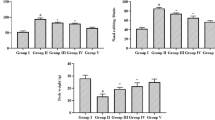Abstract
Allergic rhinitis (AR) is an allergic inflammation of the nasal airways. The Korean herbal medicine, So-Cheong-Ryong-Tang (SCRT) has been typically used for the treatment of AR for hundreds of years. In the present study, we investigated whether SCRT suppresses the progression of AR in animal model. AR was induced by ovalbumin (OVA). Treatment with SCRT was assessed to study the effect of SCRT on AR in mice. Histological analysis, multiplex cytokine assay, blood analysis, cell viability assay, RT-PCR and Elisa assay were performed to verify inhibitory effect of SCRT on AR. SCRT reduced infiltration of inflammatory cells into nasal cavity. SCRT reduced infiltration of mast cells into nasal mucosa. SCRT reduced the levels of cytokines (IL-4 and LIF) in the serum. SCRT reduced the levels of leukocytes in the blood. SCRT decreased cell viability of HMC-1 cells and splenocyte. SCRT suppressed IL-4 level in HMC-1 cells and splenocyte cells in a dose-dependent manner. SCRT suppressed IL-6 level and TNF-α level in splenocyte. SCRT suppresses the progression of AR induced by OVA. SCRT might be a useful drug for the treatment of AR.






Similar content being viewed by others
References
Wallace DV, Dykewicz MS, Bernstein DI, Blessing-Moore J, Cox L, Khan DA, Lang DM, Nicklas RA, Oppenheimer J, Portnoy JM, Randolph CC, Schuller D, Spector SL, Tilles SA (2008) The diagnosis and management of rhinitis: an updated practice parameter. J Allergy Clin Immunol 122(2 Suppl):S1–S84. doi:10.1016/j.jaci.2008.06.003
Bousquet J, Khaltaev N, Cruz AA, Denburg J, Fokkens WJ, Togias A, Zuberbier T, Baena-Cagnani CE, Canonica GW, van Weel C, Agache I, Ait-Khaled N, Bachert C, Blaiss MS, Bonini S, Boulet LP, Bousquet PJ, Camargos P, Carlsen KH, Chen Y, Custovic A, Dahl R, Demoly P, Douagui H, Durham SR, van Wijk RG, Kalayci O, Kaliner MA, Kim YY, Kowalski ML, Kuna P, Le LT, Lemiere C, Li J, Lockey RF, Mavale-Manuel S, Meltzer EO, Mohammad Y, Mullol J, Naclerio R, O’Hehir RE, Ohta K, Ouedraogo S, Palkonen S, Papadopoulos N, Passalacqua G, Pawankar R, Popov TA, Rabe KF, Rosado-Pinto J, Scadding GK, Simons FE, Toskala E, Valovirta E, van Cauwenberge P, Wang DY, Wickman M, Yawn BP, Yorgancioglu A, Yusuf OM, Zar H, Annesi-Maesano I, Bateman ED, Ben Kheder A, Boakye DA, Bouchard J, Burney P, Busse WW, Chan-Yeung M, Chavannes NH, Chuchalin A, Dolen WK, Emuzyte R, Grouse L, Humbert M, Jackson C, Johnston SL, Keith PK, Kemp JP, Klossek JM, Larenas-Linnemann D, Lipworth B, Malo JL, Marshall GD, Naspitz C, Nekam K, Niggemann B, Nizankowska-Mogilnicka E, Okamoto Y, Orru MP, Potter P, Price D, Stoloff SW, Vandenplas O, Viegi G, Williams D (2008) Allergic Rhinitis and its Impact on Asthma (ARIA) 2008 update (in collaboration with the World Health Organization, GA(2)LEN and AllerGen). Allergy 63(Suppl 86):8–160. doi:10.1111/j.1398-9995.2007.01620.x
Smurthwaite L, Walker SN, Wilson DR, Birch DS, Merrett TG, Durham SR, Gould HJ (2001) Persistent IgE synthesis in the nasal mucosa of hay fever patients. Eur J Immunol 31(12):3422–3431. doi:10.1002/1521-4141(200112)31:12<3422
Boyce JA (2003) Mast cells: beyond IgE. J Allergy Clin Immunol 111(1):24–32 (quiz 33) doi:S0091674902913229 [pii]
Borish L (2003) Allergic rhinitis: systemic inflammation and implications for management. J Allergy Clin Immunol 112(6):1021–1031. doi:10.1016/j.jaci.2003.09.015
Hamilos DL, Leung DY, Wood R, Cunningham L, Bean DK, Yasruel Z, Schotman E, Hamid Q (1995) Evidence for distinct cytokine expression in allergic versus nonallergic chronic sinusitis. J Allergy Clin Immunol 96 (4):537-544. pii S0091674995002661
Braunstahl GJ, Kleinjan A, Overbeek SE, Prins JB, Hoogsteden HC, Fokkens WJ (2000) Segmental bronchial provocation induces nasal inflammation in allergic rhinitis patients. Am J Respir Crit Care Med 161(6):2051–2057. doi:10.1164/ajrccm.161.6.9906121
Cameron L, Hamid Q, Wright E, Nakamura Y, Christodoulopoulos P, Muro S, Frenkiel S, Lavigne F, Durham S, Gould H (2000) Local synthesis of epsilon germline gene transcripts, IL-4, and IL-13 in allergic nasal mucosa after ex vivo allergen exposure. J Allergy Clin Immunol 106(1 Pt 1):46–52. pii:S0091674900635443
Nouri-Aria KT, O’Brien F, Noble W, Jabcobson MR, Rajakulasingam K, Durham SR (2000) Cytokine expression during allergen-induced late nasal responses: IL-4 and IL-5 mRNA is expressed early (at 6 h) predominantly by eosinophils. Clin Exp Allergy 30(12):1709–1716. pii:cea998
Bousquet J, Van Cauwenberge P, Khaltaev N (2001) Allergic rhinitis and its impact on asthma. J Allergy Clin Immunol 108(5 Suppl):S147–334. pii:a118891
Bascom R, Pipkorn U, Lichtenstein LM, Naclerio RM (1988) The influx of inflammatory cells into nasal washings during the late response to antigen challenge. Effect of systemic steroid pretreatment. Am Rev Respir Dis 138(2):406–412. doi:10.1164/ajrccm/138.2.406
Plaut M, Valentine MD (2005) Clinical practice. Allergic rhinitis. N Engl J Med 353(18):1934–1944. doi:10.1056/NEJMcp044141
Nathan RA (2007) The burden of allergic rhinitis. Allergy Asthma Proc 28(1):3–9
Yu C, Xiao YZ, Xun PH, Dai L, Han J, Yuan HL (2014) Preparation and characterization of cucurbitacin B sodium deoxycholate/phospholipid-mixed oral fast dissolving film and antitumor activity study. Zhongguo Zhong Yao Za Zhi 39(10):1799–1804
Nagai T, Arai Y, Emori M, Nunome SY, Yabe T, Takeda T, Yamada H (2004) Anti-allergic activity of a Kampo (Japanese herbal) medicine “Sho-seiryu-to (Xiao-Qing-Long-Tang)” on airway inflammation in a mouse model. Int Immunopharmacol 4(10–11):1353–1365. doi:10.1016/j.intimp.2004.05.021
Kao ST, Wang SD, Wang JY, Yu CK, Lei HY (2000) The effect of Chinese herbal medicine, xiao-qing-long tang (XQLT), on allergen-induced bronchial inflammation in mite-sensitized mice. Allergy 55(12):1127–1133
Kao ST, Lin CS, Hsieh CC, Hsieh WT, Lin JG (2001) Effects of xiao-qing-long-tang (XQLT) on bronchoconstriction and airway eosinophil infiltration in ovalbumin-sensitized guinea pigs: in vivo and in vitro studies. Allergy 56(12):1164–1171. pii:982
Sakaguchi M, Mase A, Ikeda Y, Iizuka A, Imamura S, Komatsu Y, Ukai K, Sakakura Y (1999) Effects of Sho-seiryu-to on experimental allergic rhinitis in guinea pigs. Methods Find Exp Clin Pharmacol 21(4):303–308
Meltzer EO (1997) The prevalence and medical and economic impact of allergic rhinitis in the United States. J Allergy Clin Immunol 99(6 Pt 2):S805–S828
Adams PF, Hendershot GE (1996) Marano MA (1999) Current estimates from the National Health Interview Survey. Vital Health Stat 10(200):1–203
Wright AL, Holberg CJ, Martinez FD, Halonen M, Morgan W, Taussig LM (1994) Epidemiology of physician-diagnosed allergic rhinitis in childhood. Pediatrics 94(6 Pt 1):895–901
Nagai T, Kiyohara H, Munakata K, Shirahata T, Sunazuka T, Harigaya Y, Yamada H (2002) Pinellic acid from the tuber of Pinellia ternata Breitenbach as an effective oral adjuvant for nasal influenza vaccine. Int Immunopharmacol 2(8):1183–1193
Lee B, Shin YW, Bae EA, Han SJ, Kim JS, Kang SS, Kim DH (2008) Antiallergic effect of the root of Paeonia lactiflora and its constituents paeoniflorin and paeonol. Arch Pharm Res 31(4):445–450. doi:10.1007/s12272-001-1177-6
Kim HM, Moon YS (1999) Asiasari radix inhibits immunoglobulin E production on experimental models in vitro and in vivo. Immunopharmacol Immunotoxicol 21(3):469–481. doi:10.3109/08923979909007121
Lee MY, Seo CS, Lee NH, Ha H, Lee JA, Lee H, Lee KY, Shin HK (2010) Anti-asthmatic effect of schizandrin on OVA-induced airway inflammation in a murine asthma model. Int Immunopharmacol 10(11):1374–1379. doi:10.1016/j.intimp.2010.07.014
Ahui ML, Champy P, Ramadan A, Van Pham L, Araujo L, Brou Andre K, Diem S, Damotte D, Kati-Coulibaly S, Offoumou MA, Dy M, Thieblemont N, Herbelin A (2008) Ginger prevents Th2-mediated immune responses in a mouse model of airway inflammation. Int Immunopharmacol 8(12):1626–1632. doi:10.1016/j.intimp.2008.07.009
Davidovich-Rikanati R, Shalev L, Baranes N, Meir A, Itkin M, Cohen S, Zimbler K, Portnoy V, Ebizuka Y, Shibuya M, Burger Y, Katzir N, Schaffer AA, Lewinsohn E, Tadmor Y (2014) Recombinant yeast as a functional tool for understanding bitterness and cucurbitacin biosynthesis in watermelon (Citrullus spp.). Yeast. doi:10.1002/yea.3049
Li XL, Zhou AG (2012) Evaluation of the immunity activity of glycyrrhizin in AR mice. Molecules 17(1):716–727. doi:10.3390/molecules17010716
Acknowledgments
This work was supported by the Kyung Hee University in 2012. This work was supported by a grant funded by the Traditional Korean Medicine R&D Project of the Ministry for Health & Welfare (No. HI12C1889).
Conflict of interest
The authors declare that there is no conflict of interest that could be perceived as prejudicing the impartiality of the research reported.
Author information
Authors and Affiliations
Corresponding author
Rights and permissions
About this article
Cite this article
Ku, J.M., Hong, S.H., Kim, S.R. et al. Anti-allergic effects of So-Cheong-Ryong-Tang in ovalbumin-induced allergic rhinitis model. Eur Arch Otorhinolaryngol 273, 123–131 (2016). https://doi.org/10.1007/s00405-015-3515-y
Received:
Accepted:
Published:
Issue Date:
DOI: https://doi.org/10.1007/s00405-015-3515-y




